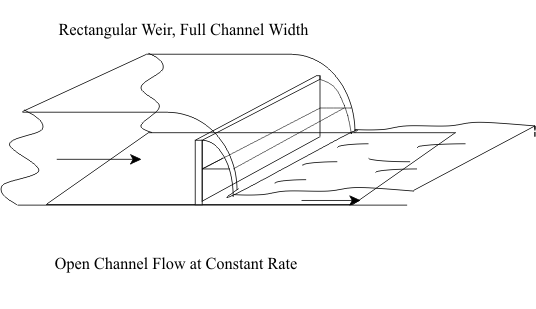
SHARP-CRESTED WEIR LAB
BACKGROUND
Weirs measure flows in open channels

Bernoulli equation for ideal flow: (q = flow per unit width)

Energy Equation: (HT = total head)
HT = H + hv = H + v2/2g
Flow Parameters
HT = H + v2/2g
v = (2g(HT - H))0.5
v = (2g H (HT/H - 1))0.5
= C (2g H)0.5
Flow Q = vA = C (2g H)0.5 A
Sharp-Crested Weirs
Weirs may be broad-crested or sharp-crested
In CE 135, we use sharp-crested weirs

Rectangular: A = L H
V-notch: A = H2.5 tan(θ/2)
Weir Equations
Q = vA
Rectangular Weir: Q = C (2gH)0.5 L H
C= arbitrary constant
Q = C (2g)0.5 L H1.5
= C L H1.5 or C H1.5
V-notch Weir: Q = C (2g H)0.5 H2 tan(θ/2)
= C H2.5 tan(θ/2) or C H2.5
For θ = 90° V-notch, C ≈ 2.5, so approximately
FOR OUR EQUIPMENT
Rectangular weir has
L = b, where b is channel width
Thus, Q = C b H1.5
V-notch weir has
Our θ = 90°, so our value should be near
Flow Over Sharp-Crested Weir


V-notch or Triangular Weir

EXPERIMENTAL SET-UP
Calibrate Two Weirs
Tap 1 (before weir)
Manometer & point gage
Seeking height above weir
Run full range of flow rates
Profile In Rectangular Channel With Weir
Taps 1-3 before weir; tap 5, 6 & 7 after weir
Skip manometer tap 4 (under weir)
Two levels between taps 4 & 6
Over-flow of weir not in manometer taps
Point gage can hit both areas
(Sketch the pattern; points vary too much to just use data points)
Supercritical flow after weir
Closs off air vent & sketch new surface pattern
Weir In Half-Meter Flume In CE Lab

Force On Weir
Taps A-F
Water height above weir top

Direct Measurement:
Hydrostatic Force:
F = γb((zw-z0)2-((zw-z0+yw)2)/2








